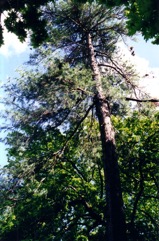White Pine, Eastern White Pine

It is a temperate plant. It grows naturally in woods at low altitude in North America. It is cultivated in N China. They can tolerate frost. It grows on light moist soils. It suits hardiness zones 3-9. Hobart Botanical Gardens.
Also known as:
Bei mei qiao song, Gladki bor, Weymouth pine
Synonyms
- Leucopitys strobus (L.) Nieuwl.
- Pinus nivea Booth ex Carriere
- and others
Edible Portion
- Seeds, Bark, Leaves - tea, Cones
Where does White Pine grow?
Found in: Australia, Britain, Canada, Central America, China, Europe, Guatemala, Korea, Mexico, North America, Norway, Papua New Guinea, PNG, Scandinavia, Slovenia, Sweden, Tasmania, United States
Notes: There are over 100 species of Pinus. The tea is rich in Vitamins A and C.
Growing White Pine, Eastern White Pine
Cultivation: Plants are grown from seed.
Edible Uses: The inner bark is dried and pounded into small pieces and added to flour. It is then milled and used to bake bread. The fresh needles are brewed into tea. Caution: The tea should not be drunk in large amounts. It should not be drunk by pregnant women. The fresh new shoots are boiled in syrup to make candy. The firm unexpanded male cones are boiled or stewed with meat.
Production: Trees grow rapidly. Trees can live 100-200 years. Cones take 2 years to mature.
Nutrition Info
per 100g edible portion| Edible Part | Energy (kcal) | Protein (g) | Iron (mg) | Vitamin A (ug) | Vitamin c (mg) | Zinc (mg) | % Water |
|---|---|---|---|---|---|---|---|
| - | - | - | - | - | - |
White Pine, Eastern White Pine Photos

References
Beckstrom-Sternberg, Stephen M., and James A. Duke. "The Foodplant Database." http://probe.nalusda.gov:8300/cgi-bin/browse/foodplantdb.(ACEDB version 4.0 - data version July 1994)
Bodkin, F., 1991, Encyclopedia Botanica. Cornstalk publishing, p 803
BRIGGS & SIMONOVITCH,
Coombes, A.J., 2000, Trees. Dorling Kindersley Handbooks. p 73
Cundall, P., (ed.), 2004, Gardening Australia: flora: the gardener's bible. ABC Books. p 1050
DILLINGHAM,
Facciola, S., 1998, Cornucopia 2: a Source Book of Edible Plants. Kampong Publications, p 171
Farrar, J.L., 1995, Trees of the Northern United States and Canada. Iowa State University press/Ames p 44
Fu Liguo, Li Nan, Mill, R.R., Pinaceae. Flora of China.
Harris, E & J., 1983, Field Guide to the Trees and Shrubs of Britain. Reader's Digest. p 256
Hibbert, M., 2002, The Aussie Plant Finder 2002, Florilegium. p 235
http://www.botanic-gardens-ljubljana.com/en/plants
Kermath, B. M., et al, 2014, Food Plants in the Americas: A survey of the domesticated, cultivated and wild plants used for Human food in North, Central and South America and the Caribbean. On line draft. p 663
Kiple, K.F. & Ornelas, K.C., (eds), 2000, The Cambridge World History of Food. CUP p 1878
Little, E.L., 1980, National Audubon Society Field Guide to North American Trees. Alfred A. Knopf. p 296
Lord, E.E., & Willis, J.H., 1999, Shrubs and Trees for Australian gardens. Lothian. p 87
MacKinnon, A., et al, 2009, Edible & Medicinal Plants of Canada. Lone Pine. p 33
Moerman, D. F., 2010, Native American Ethnobotany. Timber Press. p 413
Plants for a Future database, The Field, Penpol, Lostwithiel, Cornwall, PL22 0NG, UK. http://www.scs.leeds.ac.uk/pfaf/
Schuler, S., (Ed.), 1977, Simon & Schuster's Guide to Trees. Simon & Schuster. No. 35
Sp. pl. 2:1001. 1753